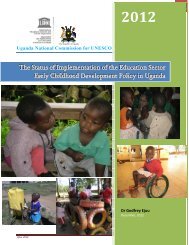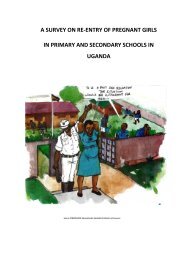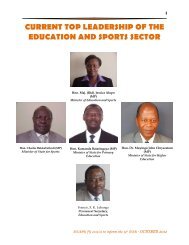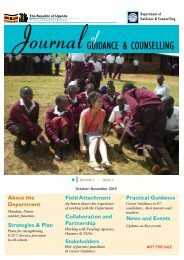Part I - Ministry Of Education and Sports
Part I - Ministry Of Education and Sports
Part I - Ministry Of Education and Sports
You also want an ePaper? Increase the reach of your titles
YUMPU automatically turns print PDFs into web optimized ePapers that Google loves.
Figure: 4.3.Stock of classrooms in secondary FY 2010/1120112012<br />
No. of Classrooms<br />
14,000<br />
12,000<br />
10,000<br />
8,000<br />
6,000<br />
4,000<br />
2,000<br />
‐<br />
2007 2012<br />
Classrooms 8,390 12,438<br />
Source: EMIS 2011/12<br />
(vii) Ratio of girls to boys in Secondary education<br />
Prior to the introduction of Universal Secondary <strong>Education</strong> in 2007, Secondary education enrolment<br />
was heavily skewed in favor of males where 63% were male while 37% were females. Since the<br />
inception of USE, there has been a change in the level of participation of girls as evidenced by the<br />
increased percentage of girls which stood at 47% in 2011. The sub – sector has continued to put in<br />
place strategies that will enable increased participation for girls. These include: creation of an enabling<br />
school environment for girls; bursary scheme for the needy students where 75% are girls; increasing<br />
the number of secondary schools under the USE programme through the PPP arrangement that has<br />
reduced the distances travelled by students; <strong>and</strong>, provision of accommodation facilities in hard to<br />
reach seed secondary schools.<br />
Table: 4.12. Percentage ratio of girls to boys in Secondary education<br />
FY 2010/11 2011/12<br />
Male 53% 53.7%<br />
Female 47% 46.3%<br />
Source: EMIS 2011<br />
(d) Constraints/Challenges<br />
(i) Sustaining increased access to secondary education without compromising quality;<br />
(ii) Persistent high student classroom ratios. The sector continues to grapple with high student<br />
classroom ratios despite the fact that they are constructing more classrooms <strong>and</strong> taking on<br />
additional private schools under the PPP arrangement;<br />
(viii) Persistent shortage of teachers for science, math, <strong>and</strong> physical education especially in rural<br />
areas. The situation has worsened with the implementation of the UPOLET programme; <strong>and</strong>,<br />
(ix) Absence of teachers’ accommodation which makes teacher deployment <strong>and</strong> retention very<br />
difficult especially in hardtoreach <strong>and</strong> hardtostay areas.<br />
ESSAPR FY 2011/12 to inform the 19 th ESSR – OCTOBER 2012<br />
49








